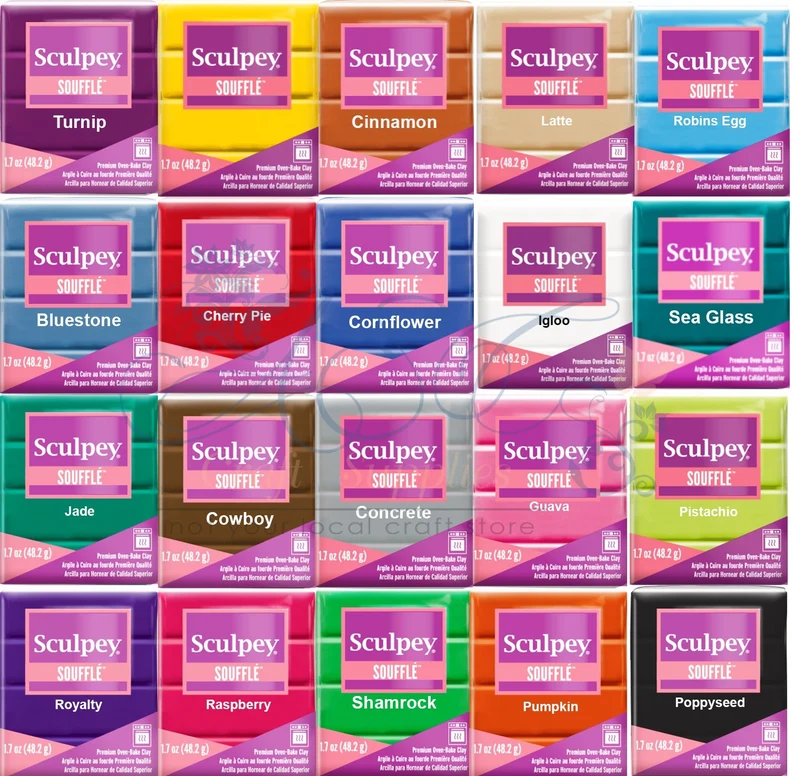Polymer clay is extremely lightweight, flexible, and durable when cured and is much more versatile in use than air dry clay. Air-dry clay is not recommended for jewelry making because it’s brittle and can break and damage very easily.
Polymer clay is made from a polymer polyvinyl chloride (PVC) combined with plasticizers, which make it soft and pliable until it’s cured in an oven. Unlike traditional clay, polymer clay does not dry out, allowing for endless crafting time and intricate details.
These features allow polymer clay to be used for many different things, including jewelry and other accessories. Because it does not harden over time, it allows for long term clay storage of canes, or other designx meant for later use.
Most polymer clay is flexible to some extent after baking, however, there are many different kinds of polymer clay, not all of them being suitable for jewelry making.
It is totally up to the artist to find their preferences and their favorite brands. I will list some of the most popular brands of polymer clay, and the different products, as well as links to where to find the clay.
The brands most suited for jewelry making are; Sculpey, Kato Polyclay, Fimo, and Cernit. However, one must note that each of these brands has its own pros and cons, as well. The brand preference is totally up to the artist.
Sculpey Clay
Sculpey is by far the most popular brand of polymer clay among the jewelry circle. A lot of the Sculpey polymer clay is soft and doesn’t take much kneading before it is ready to use. Sculpey also offers a wide variety of colors.
Sculpey offers many different types of clay, including air dry clay, and polymer clay geared towards children and other less professional projects such as Sculpey III. Sculpey III is polymer clay, but it acts quite similar to air-dry clay when cured. Sculpey III clay lacks the flexibility of the other variations and it’s dry. It can crumble and snap very easily after it is baked.
The best Sculpey clays to use for jewelry are, Sculpey Premo and Sculpey Souffle. Both of these are soft and come in a beautiful variety of colors.
Here is a link to the Sculpey store, where you can find both the Premo and Souffle brands. https://www.sculpey.com/products/polymer-clay/premo-sculpey2

Kato Polyclay
Kato Polyclay is another brand of polymer clay that is used in jewelry making. It is one of the more stiff polymer clays and needs a lot of work before it is soft enough to make jewelry with. The best way to condition this clay is to purchase a clay conditioner. Clay conditioner is a liquid that helps to break down the polymers and soften the clay, thus making kneading easier. A clay press is another way to take the strain off one’s hands, as it will do all the work for you instead.
The end products made from Kato Polyclay are high quality, however, they come at a more laborious cost than those made from Sculpey clay. Kato Polyclay also only offers limited primary colors, so custom color mixing is required if the artist wants to achieve a greater spectrum of shades.
Here is a link to the Kato Polyclay store: https://www.katopolyclay.com/

Fimo Clay
Fimo is a softer clay, similar to Sculpey, but not quite as soft. They also offer a range of colors, however not quite as many as Sculpey. Fimo polymer clay is a German brand though it can be found in some craft stores in North America. Of course, if you are willing to pay a little extra, it is also easily available to purchase online.
Fimo has a few different lines of polymer clay, similar again to Sculpey. Some of the variations include; Fimo, Fimo Professional, Fimo Soft, Fimo Effect, and Fimo Kids. The Fimo Kids clay is similar to Sculpey III in a few ways; it’s a lower-quality polymer clay meant for kids to experiment and play with. It’s not recommended for jewelry making, as it can crumble and break easily.
Fimo Effect clay, has a leather look to it when baked, giving your projects a unique texture variation. There is still some color mixing required if one wants a fully custom color palette.
Here is the link to the Fimo clay store: https://www.staedtler.com/us/en/discover/fimo-made-by-you/

Cernit Clay
Cernit is also a European polymer clay, and it’s not as easily available in North America as it is elsewhere. Out of all the polymer clay available on the market for jewelry making, Cernit is by far the most difficult to get your hands on, it is also one of the most expensive.
Cernit is a moderate clay, not soft, but not as hard as Kato Polyclay either. It comes in many beautiful colors, and Cernit also offers the most purely translucent clay on the market. Other clay brands offer translucent clay, however, they tend to be a bit yellow when cured, whereas Cernit translucent clay will hold its color.
Here is the link to purchase Cernit polymer clay: https://www.clayfactory.net/cernit/index.html

I hope you enjoyed this article and found it helpful! This is very useful knowledge when starting out making professional polymer clay projects. It’ll help spare you some trial and error, and give you a variety of clays to experiment and mix in your art.
-Sofie

